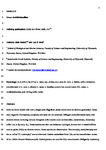Acidithiobacillus
| dc.contributor.author | Boden, Rich | |
| dc.contributor.author | Hutt, L | |
| dc.date.accessioned | 2020-09-15T12:07:21Z | |
| dc.date.issued | 2019-12-16 | |
| dc.identifier.isbn | 1118960602 | |
| dc.identifier.isbn | 9781118960608 | |
| dc.identifier.uri | http://hdl.handle.net/10026.1/16340 | |
| dc.description | File replaced (incorrect version) on 28/7/2022 by KT (LDS). | |
| dc.description.abstract |
A.ci.di.thi.o.ba.cil'lus. L. masc. adj. acidus sour, tart; Gr. neut. n. theîon sulfur, brimstone (transliterated to L. neut. n. thium); L. masc. n. bacillus a short rod, a short wand; N.L. masc. n. Acidithiobacillus acid‐loving sulfur rodlet. Proteobacteria / Acidithiobacillia / Acidithiobacillales / Acidithiobacillaceae / Acidithiobacillus Cells are short, motile rods with a single polar flagellum. Some strains have an obvious glycocalyx. Gram‐stain‐negative. Endospores, exospores, and cysts are not produced. Obligate chemolithoautotrophs, with electron donors including reduced inorganic sulfur species such as thiosulfate, tetrathionate, and elementary sulfur (viz. α‐S8 and μ‐S∞). Some species can also use molecular hydrogen, ferrous iron, or metal sulfides such as pyrite (FeS2) as electron donors. Some species are diazotrophic. Heterotrophy, methylotrophy, and the so‐called C1 autotrophy are not observed. Carbon assimilated from CO2 via the transaldolase variant of the Calvin–Benson–Bassham cycle. Carboxysomes are used for CO2 concentration. Obligately respiratory, with molecular oxygen, ferric iron, or elementary sulfur as terminal electron acceptors, varying by species. Most strains grow in the range of 20–37°C, though some have a narrower range, and one species is thermophilic. Optimal growth from pH 2.0 to 5.8 and an overall range of pH −0.6 to 6.0. The major respiratory quinone is ubiquinone‐8 (UQ‐8), and traces of ubiquinone‐9 (UQ‐9), ubiquinone‐7 (UQ‐7), and menaquinones (MK) are found in some species. The dominant fatty acids are palmitic acid (C16:0), vaccenic acid (C18:1), cis‐11‐cyclopropyl‐nonadecanoic acid (C19:0 cyclo ω8c), palmitoleic acid (C16:1), myristic acid (C14:0), and lauric acid (C12:0). The dominant polar lipids are cardiolipin, aminolipids, phospholipid, phosphatidylglycerol, and phosphatidylethanolamine. The G + C fraction of genomic DNA is around 52.0–63.9 mol%. Form IAc (carboxysomal) and Form II (cytoplasmic) d‐ribulose 1,5‐bisphosphate carboxylase/oxygenase are used, as are forms bo 3 and bd‐I ubiquinol oxidases and, in the iron‐oxidizing species, the aa 3‐type cytochrome c oxidase. A description of Acidithiobacillus concretivorus comb. nov. is also given. DNA G + C content (mol%): 52.0–63.9. Type species: Acidithiobacillus thiooxidans Kelly and Wood 2000VP (Thiobacillus thiooxidans Waksman and Joffe 1922AL). | |
| dc.format.extent | 1-19 | |
| dc.language.iso | en | |
| dc.publisher | Wiley | |
| dc.relation.ispartof | Bergey's Manual of Systematics of Archaea and Bacteria | |
| dc.rights | Attribution-NonCommercial-NoDerivatives 4.0 International | |
| dc.rights | Attribution-NonCommercial-NoDerivatives 4.0 International | |
| dc.rights | Attribution-NonCommercial-NoDerivatives 4.0 International | |
| dc.rights.uri | http://creativecommons.org/licenses/by-nc-nd/4.0/ | |
| dc.rights.uri | http://creativecommons.org/licenses/by-nc-nd/4.0/ | |
| dc.rights.uri | http://creativecommons.org/licenses/by-nc-nd/4.0/ | |
| dc.subject | Acidithiobacillia | |
| dc.subject | Acidithiobacillus | |
| dc.subject | acidothermophiles | |
| dc.subject | biomining | |
| dc.subject | chemolithoautotrophs | |
| dc.title | Acidithiobacillus | |
| dc.type | chapter | |
| plymouth.publisher-url | https://onlinelibrary.wiley.com/doi/10.1002/9781118960608.gbm01079.pub2 | |
| plymouth.publication-status | Published online | |
| dc.identifier.doi | 10.1002/9781118960608.gbm01079.pub2 | |
| plymouth.organisational-group | /Plymouth | |
| plymouth.organisational-group | /Plymouth/Faculty of Science and Engineering | |
| plymouth.organisational-group | /Plymouth/Faculty of Science and Engineering/School of Biological and Marine Sciences | |
| plymouth.organisational-group | /Plymouth/REF 2021 Researchers by UoA | |
| plymouth.organisational-group | /Plymouth/REF 2021 Researchers by UoA/UoA06 Agriculture, Veterinary and Food Science | |
| plymouth.organisational-group | /Plymouth/Users by role | |
| plymouth.organisational-group | /Plymouth/Users by role/Academics | |
| dc.publisher.place | USA | |
| dc.rights.embargodate | 2020-12-16 | |
| dc.rights.embargoperiod | Not known | |
| rioxxterms.version | Version of Record | |
| rioxxterms.versionofrecord | 10.1002/9781118960608.gbm01079.pub2 | |
| rioxxterms.licenseref.uri | http://creativecommons.org/licenses/by-nc-nd/4.0/ | |
| rioxxterms.type | Book chapter |



